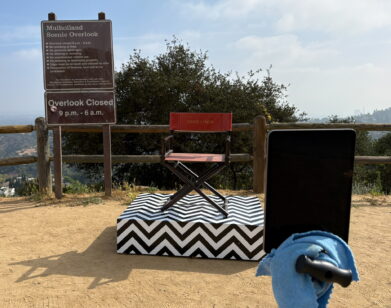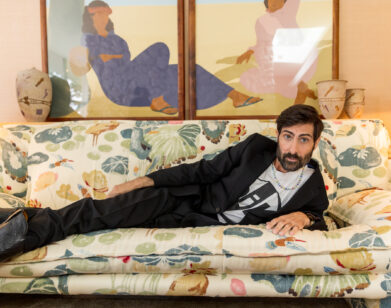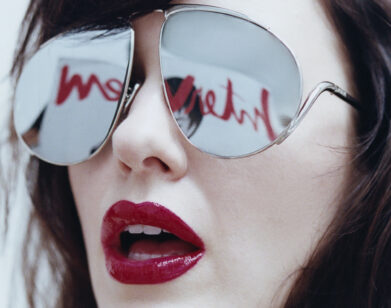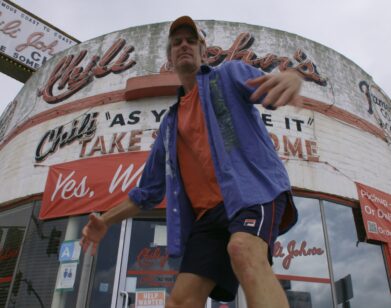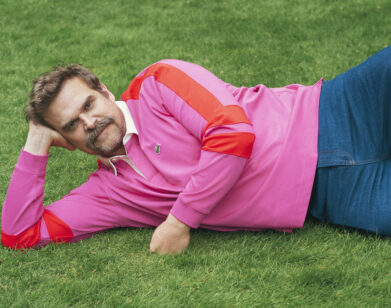Sundance 2011: Exploring The Woods with Matthew Lessner
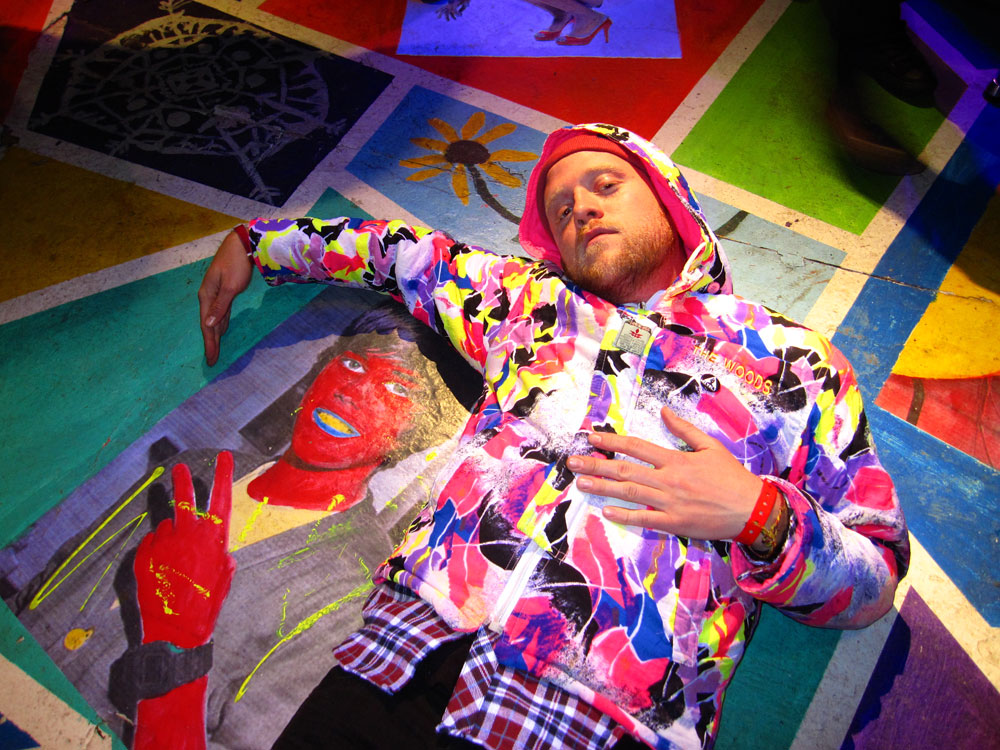
THE WOODS ACTOR JUSTIN PHILLIPS. PHOTO BY DEENAH VOLLMER
No group made a more colorful impression on Sundance than the cast and crew of The Woods. A little bit art school, a little bit thrift shop, a little bit rainbow raver, and a little bit flower child, what The Woods had most was style. They walked around in Day-Glo ’80s parkas with the name of their film embroidered on the back, they passed out stickers, they wore face paint to their screenings, and they danced like crazy at the late night parties.
Matthew Lessner, 27, who previously directed music videos for The Dirty Projectors and The Raveonettes, and a couple festival-sanctioned short films, got a group of young filmmakers, designers, and friends live in the woods for a month and make a feature film. They found discarded appliances, borrowed taxidermy, and built two camps: one as a set and one for them to live in. He paid for the project by maxing out credit cards and was only able to finish it years later, through a Kickstarter campaign. In fact, The Woods was the first film at Sundance to have used Kickstarter for funding.
Shot on film, the movie is a very funny throwback portrait of a group of hipster idiots who move to the woods to foment political rebellion. They don’t do much but eat Cheez-Its, shoot each other with water guns loaded with paint, update their Facebook pages, jet-ski, create art installations, screw flat-screen TVs into trees, and look pretty.
We had the pleasure of talking to director Matthew Lessner at Sundance.
DEENAH VOLLMER: Can you begin by telling me how you came up with the idea for the film?
MATTHEW LESSNER: The idea started from this feeling that I’ve had for most of my adult life, and influenced the last film I made, By Modern Measure, that I was here [at Sundance] with a couple years ago. It’s this sense of wanting to take some action, in terms of all the crazy problems that we’re facing in the world, but not knowing what to do. I look back to the ’60s and I think about the Vietnam War and the civil rights movement. They were these really cohesive things that young people were focusing on, to try to make a positive impact. Now it seems like there’s just so much going on, things are spread so thin, that I’m not exactly sure what to do. So it seemed like making a movie would be a way to express that feeling of still not really knowing exactly what to do.
VOLLMER: Would you consider it a political film, then?
LESSNER: I don’t know “political”—I consider it satire, sort of social satire. Maybe a tad bit of political satire, but I guess more social than overtly political. But it’s also a comedy.
VOLLMER: Your cast and crew spent a month living in the woods. What was that like?
LESSNER: It was pretty crazy. Part of what motivated a lot of people to want to do it is, I think, the feeling of being so wired and tapped in.For a lot of us there’s this appeal to getting back to the land. A lot of young people that I’ve spoken with have this similar romantic notion of reconnecting with the natural world. The shooting very closely mirrored what’s going on in the film. We were all living in tents in the woods for a month, showering outdoors and having our food brought in every couple days, just trying to keep offline and not pay attention to what was going on in terms of the news and social media or whatever.
VOLLMER: Did you ever consider making it more of a documentary?
LESSNER: No, because I wanted—it’s very stylized. There’s a weird thing going on in the film in terms of the aesthetic approach: there’s definitely a documentary element. But in terms of people’s behavior, it’s hyper-realistic. I think the way the people are acting is not the way normal people would be behaving. And in terms of the satirical element, it was important to me that their characters be these exaggerated versions.
VOLLMER: Is there anything that you experienced living in the woods that you added to the film that you didn’t expect to before you started?
LESSNER: Certainly. We knew the story we were trying to tell, but we also knew that by virtue of living out in the woods for this period of time, things would come up. Maybe two characters would be interacting with each other in a particular way, or maybe we’d come across a snake on the path. And it was also, because so many of our props and equipment and even animals were donated by the local community, things would pop up halfway through shooting. The story remained the same throughout, but all those weird elements that pepper the film were shifting.
VOLLMER: Stylistically and aesthetically, I noticed elements of the ’60s, the ’70s, the ’80s, the ’90s, and the ’00s. Was that on purpose?
LESSNER: I think it’s fun to play with different generational aesthetics. In terms of shooting on Super 16 and a lot of the handheld approach, we wanted to hearken back to the look of a lot of the films from the late ’60s, early ’70s when this sort of communal living was more popular. There’s a lot of films from that era and even complete aesthetics from that era that we wanted to touch on. But at the same time, these kids in the film are all kids that grew up in the 90s, and a lot of them are in this prolonged childhood. Their youth was the ’90s, so there’s definitely a lot of ’90s aesthetic vibes—some films that really influenced me growing up.
VOLLMER: Can you name some of them?
LESSNER: Camp Nowhere is one of the primary aesthetic touchstones from the ’90s that I really enjoyed. And it has a similar sensibility, to a certain degree. It’s a Disney kids’ film, but it’s about a group of kids who go out and start their own camp.
VOLLMER: The scene with all the colored paint squirting really reminded me of the food fight from Hook.
LESSNER: Awesome. Awesome.
VOLLMER: Did you consider that at all?
LESSNER: I didn’t at the time, but I’ve actually just gone back and watched that recently and that was definitely something that could have influenced me subliminally because that was a big film for me growing up as well. That’s cool to hear. Hook has great colors.
VOLLMER: There’s a lot of parallels with The Lost Boys as well.
LESSNER: Yeah, actually. I never even thought about that directly, but yeah, there totally is. It’s weird how you can be influenced by things you’ve seen without directly referencing them or sitting down and making that something that you’re trying to.
VOLLMER: I noticed some similarity between the social networking that the characters in the film used and the social networking that you used to get the film out there. Can you comment on that at all?
LESSNER: That was kind of funny, actually, because at the time that we shot the film, I did not have a strong online social-networking presence. The way we initially funded the film was basically on personal credit cards, just doing it ourselves. Once that petered out, once the financial collapse happened, and credit started drying up, we needed another option. Kickstarter was mentioned to me by a friend who was using it to finance this sailing trip around the world that she is on right now.
The film is not a celebration of social media, but it’s not a direct condemnation. But it is weird that the way we were finally able to get it together was by embracing the site. Other sites seem more narcissistic to me. But I like the idea of the Internet in general being something that is more egalitarian, andmore supportive of things.
VOLLMER: The soundtrack was one of my favorite parts of the film.
LESSNER: Awesome!
VOLLMER: How did you connect with Lucky Dragon?
LESSNER: I connected with Lucky Dragon through David Longstreth from Dirty Projectors in the year that I stopped shooting the film, when I directed a bunch of music videos because I needed something to do to stay afloat. One of the bands I did a music video for was Dirty Projectors, and I became friends with David Longstreth. We used one of his older tracks in the movie and in the course of editing I really fell in love with a bunch of Lucky Dragon’s tracks and thought they were perfect. Dave was good friends with Luke from Lucky Dragon, so I reached out.
Then Lydia, who did the score, which I am continually blown away by, she contacted me out of the blue. She just graduated from NYU last year and had written a piece of music which is now the intro piece of the film. And she sent it to me and said, “I’ve got this track, I wanted to mash it up with some found footage but I couldn’t get the rights to it. Would you have any use for it?” and I thought, “This is amazing.” And she continued to work and actually score a bunch of stuff that’s original in the film. A couple of people, just bands, there’s an Indian Jewelry track that I had just been using to edit with for awhile, and I just reached out to them directly, and they were cool.
VOLLMER: How did you find your actors?
LESSNER: A lot of them are either people I went to school with or people that I just sort of met at festivals. A lot of them pursue other creative endeavors; directors, musicians, but none of them, at least at the time, were explicitly pursuing acting. It was definitely suggested to us by a bunch of producers that we wait a little bit longer and cast some up-and-coming TV actors, someone that’s got some more cachet, but it was important to us that we could have this fully immersive process, and it seemed that the best way we could do this was to have people that were down-to-earth and excited to do it and didn’t need to be in trailers or coddled in any particular way and were fine to just all share in this experience. In that way I feel like it needed to be made in that way with these people.
VOLLMER: My main criticism of the film was that it never rained.
LESSNER: [laughs]
VOLLMER: Wouldn’t it have rained in that time period in Oregon in the forest?
LESSNER: Ummm, perhaps, but I would also say that they are powering their flat-screen TVs through light switches in the trees—so there’s a certain amount of surreality going on.


